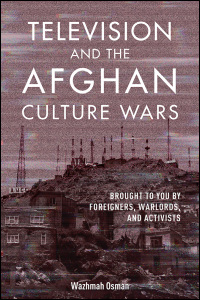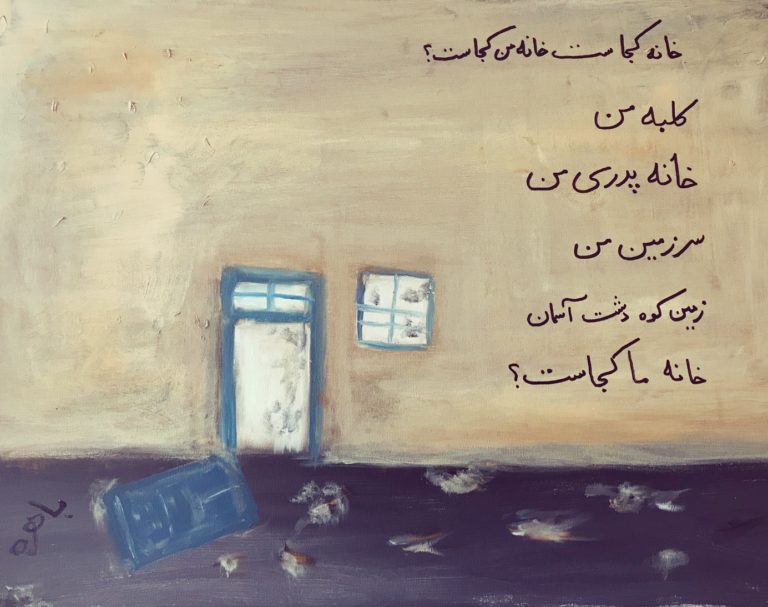This review examines Wazhmah Osman’s book Television and the Afghan Culture Wars, an ethnographic study of television media in Afghanistan. The book explores the Afghan mediascape through richly detailed interviews with media industry professionals and local Afghans, which provide a realist portrayal of the perils and triumphs of media houses in Afghanistan, local cultural contestations, changing gender norms, and the role and reception of television in the nation’s rather tumultuous political and cultural life. Osman deflates the dominant notion in Western discourses of Afghanistan as a “hopeless landscape of powerless people,” (2) arguing that there is a thriving, internationally backed media infrastructure and a hopeful, culturally conscious citizenry in the nation. She argues that despite Afghanistan’s history of violence, ethnic tensions, atrocities against women, and imperialistic agendas by foreign powers, the Afghan media sector is a widely accessible platform for retribution against years of underdevelopment and war, with “the potential to underwrite democracy, national integration, and peace” (3).
Keyword: representation
Arctic Pedagogy: Indigenous People and the MACOS Culture War
This paper is about the place of Indigenous people in an early instance of a culture war in the United States: the conflict in the 1970s over an innovative middle-grades social studies curriculum called “Man: A Course of Study” (MACOS). Funded by the National Science Foundation, MACOS sought to revamp social studies education by addressing big questions about humans as a species and as social animals. It quickly came under fire from conservatives and helped to solidify the concept of “secular humanism” as a social threat. A broad conservative organizing effort, whose effects can still be felt today, eventually ended not only MACOS, but the very viability of school curriculum reform projects on the national level. Though this story is familiar to historians of American education, this paper argues for its centrality to the development of contemporary conservative politics and the early history of the culture wars. It also takes up the largely unaddressed issue of how Indigenous people figured in the MACOS curriculum and in the ensuing controversy. Focusing on the ethnographic film series featuring Netsilik Inuit that was at the heart of the MACOS curriculum, this paper addresses the largely unacknowledged legacy of Indigenous pedagogy, to argue that the culture war that led to the demise of the MACOS project also represented a lost opportunity for Indigenous knowledge and teaching to be incorporated into the formal schooling of American children.
Commodifying Tragedy: Representing Violence against Native American Women in The Cold Dish and Longmire
By focusing on the representation of violence against Native American women in Craig Johnson’s The Cold Dish and the television show Longmire, this article demonstrates how these cultural productions perpetuate settler-colonial power relations. Although Longmire is one of the more progressive shows thanks to its development of Native American characters and storylines, the settler-colonial status quo is affirmed in four main ways. Not only do the novel and TV show redeploy the racist stock characters of the Magical Indian and the White Savior, but the TV show especially also reiterates a version of the stereotypical Vanishing American narrative inherited from the Western genre. Furthermore, both cultural productions heavily pathologize the Cheyenne community, depriving them of agency. Finally, the novel and show both transform pain, suffering, and grief into transferable commodities. This allows them to disinvest the pain and tragedy suffered by the Native American characters in order to reinvest this tragic potential in white characters, which serves to reinforce the white characters’ heroism. The commodification of tragic potential and emphasis on its sentimentalization help obscure the settler-colonial origins and systemic perpetuation of violence against Native American women. In sum, this analysis shows that the deeply ingrained and normalized settler-colonial ideology inherent to representational strategies limit the progressive potential of even the most benevolent and well-meaning white cultural productions.
Disruptions—An interview with Jacques Rancière
This interview concerns the premise of ‘aesthetics’, as a certain regime of identification, which intervenes within the domain of ‘politics’ and ‘history of art’, as configured in the ideations of Jacques Rancière. From this general premise the discussion provokes us to particularly re-configure the concept of ‘modernism’ in art that is not solely defined through simplistic comparisons with ‘post-modernism’. Instead, a re-configuration of ‘modernism’ lets us reconsider the ‘Avant Garde’ project from the methodology of an ‘aesthetic community’ formulated during the French revolution existing still in the texts of the young Marx of the 1840s. The logic of representations in art moves beyond the objective structures of ‘Dialectical Reason’, and instead gets aligned to the aesthetic logic of being spatio-temporally ‘surplus’. Furthermore, it is the aesthetic logic that introduces the heterogeneity of political symbolizations that underlines a multiplicity of process as against a distinct strategy linking theory and practice thus even challenging a global rationality of defining ‘what is art?’ (Art History) and ‘what is politics?’ (Politics). It is based upon these contingent reversals of the signification of the world, of trying to identify the singular points of disruptions connecting to or not connecting to make a whole, that the interview concludes with questions on the multiplicity of possibles.
Troubling the Home/Land in Showtime’s Homeland: The Ghost of 1979 and the Haunting Presence of Iran in the American Imaginary
In my close reading of the drama series Homeland, I illustrate how the divisive pull between “fascination and contempt, desire and disgust” as well as the “simultaneous embracing and disavowal” that cultural critics argue define Iranian Americanness become embodied in the character Fara, a young Muslim Iranian American woman recruited into the CIA for her language and technical skills. This essay asks, among other questions: what does it mean to have anxiety over your birthplace or ancestral homeland? What does a “simultaneous embracing and disavowal” do to a person over time? I argue that as a consequence of how her body is read, Fara is continually denied access to a home and a land and ultimately becomes discarded after performing her role as an agent of the state apparatus. In addition, this essay considers how the ghost of the Iranian hostage crisis of 1979 is frequently invited to speak as an origins myth for contact between the US and Iran that subsequently shapes the lived realities of Iranian Americans nearly forty years later.




